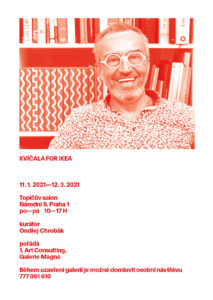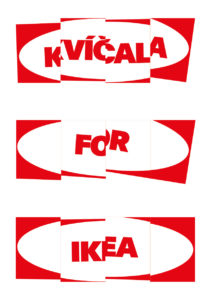- LOADING...
-
- Kvíčala for IKEA, 2021
- Kvíčala for IKEA, 2021
- Kvíčala for IKEA, 2021
- „It started with a napkin....“
- Kvíčala for IKEA, 2021
- Art&Architecture
- Kvíčala for IKEA, 2021
- white monochromes
- Detail
- Art&Architecture
- Kvíčala for IKEA, 2021
- Art&Architecture
- Kvíčala for IKEA, 2021
- Kvíčala for IKEA, 2021
- Graffiti, 2020
- Kvíčala for IKEA, 2021
- Samizdat 80's
- Kvíčala for IKEA, 2021
- Kvíčala for IKEA, 2021
1 / 23Exhibition:2021, Kvíčala for IKEA, Topičův salon, Praha

Virtual tour of exhibition – https://my.matterport.com/show/?m=Qrgyig6Nu2t
KVÍČALA FOR IKEA
An anecdote from the era of COVID curatorship
„It started with a napkin. A napkin with wavy lines that was part of the table set during a late supper at Petr Kvíčala’s home. “That’s not Kvíčala, that’s IKEA”, the artist’s wife answered with a laugh before I even asked. A wavy line is an integral part of the artist’s work and image as a postmodern artist brand he has been building consciously. Over the last three decades, it has appeared on canvas in various colours, thicknesses and lengths, as well as in Kvíčala’s numerous architectural assignments. Indeed, Kvíčala’s business cards display a wavy line instead of his name. An Internet research showed that the wavy lines on the napkins were the work of a British designer whose certain other works betray visual affinity with Kvíčala’s paintings. Generally, it can be said that designer inspirations and borrowings from the visual experiments of geometrical abstractionists have de facto turned this art tendency into a prime source of contemporary ornamentics. The extent to which the sources are admitted often depends merely on their general popularity. You cannot conceal being inspired by PietMondrian; it is much easier to conceal being inspired by the works of artists from areas with less developed art traffic. The debate on to what extent the similarity of a napkin is purely incidental is endless, since information is accessible from anywhere at any time thanks to the Internet today, yet the combinatorialoptions of using a wavy line and other geometric elements are too limited to exclude the possibility of two different artists achieving identical results fully independently. In the very least, we can agree that global chains definitely employ more and better lawyers than an art school teacher in Brno can afford. Over eggnog, we figured out a solution to the issue: all you need to do is sign the napkin! With this primitive trick, you can reverse the case to your benefit, since appropriation etches the seriousness and reputability of artistic originality because it turns it upside down with the exact dose of irony. The idea met with success, because it means appropriation to the power of two where the artist appropriates the actual strategy of appropriation including its extended family tree that reaches all the way to Warhol’s soup cans and Rauschenberg’s eraser. While still at the table, a decision was made to the effect that this would not end with a signed napkin – this would give rise to a full new series of paintings titled KVÍČALA FOR IKEA, as well as to an entire exhibit of the same name. After all, corporate marketing has long been known to involve artists in campaigns– a notorious vodka bottle can be one example to illustrate all. Artist and designer involvement in the form of ‘collab’, or collaboration that spawns limited series of products, is becoming increasingly popular currently. When it comes to the KVÍČALA FOR IKEA exhibit, ‘guerrilla collab’would bethe best description of the format.“
Ondřej Chrobák
Prague, 9 January 2021
KVÍČALA FOR IKEA
aneb historka z doby covid-kurátorování
„Začalo to ubrouskem. Ubrouskem s vlnovkami, který byl součástí prostírání při pozdní večeři u Petra Kvíčaly. „To není Kvíčala, ale IKEA“, odpoví se smíchem umělcova žena dřív, než se stačím zeptat. Vlnovka patří neodmyslitelně k umělcově tvorbě a image, jako cíleně budovaný postmoderní umělecký brand. Kromě malířského plátna se v posledních třech dekádách objevila v různých barvách, tloušťkách a délkách také v četných Kvíčalových realizacích v architektuře. Konečně na vizitce má Kvíčala vlnovku místo jména. Rešerše na internetu ukázala, že vlnovky na ubrousku jsou dílem britské designérky, jejíž některé další práce vykazují vizuální afinitu s Kvíčalovými obrazy. Obecně lze konstatovat, že designerské inspirace a výpůjčky z vizuálních experimentů geometrické abstrakce udělaly z této umělecké tendence de facto hlavní reservoár současné ornamentiky. Nakolik jsou zdroje přiznané, záleží často asi pouze na jejich obecné známosti. Inspiraci Pietem Mondrianem neutajíte, inspirace díly umělců z oblastí s méně rozvinutým provozem umění skryjete daleko spíš. Diskuze, nakolik se v případě ubrousku jedná o podobnost čistě náhodnou, nemá konce, protože dnes jsou sice informace díky internetu dostupné kdykoliv odkudkoliv, ale na druhou stranu kombinatorické možnosti použití vlnovky i jiných geometrických prvků jsou značně limitní, aby na stejné výsledky nešlo dojít zcela nezávisle. Shodneme se minimálně na tom, že globální řetězce zaměstnávají rozhodně víc a lepších právníků, než si může dovolit profesor umělecké školy z Brna. U vaječného koňaku nás ale napadlo řešení situace: stačí přece ten ubrousek signovat! Tímto triviálním trikem obrátit věc ve svůj prospěch, neboť apropriace působí jako kyselina na vážnost a váženost umělecké originality, protože ji s přesně dávkovanou ironií staví na hlavu. Nápad měl úspěch, protože se jedná o apropriaci na druhou, kdy si umělec přivlastní samotnou strategii apropriace s jejím dlouhým rodokmenem plným kontroverzí táhnoucích se až někam k Warholovým plechovkám s polívkou a Rauschenbergově gumování. U stolu rychle klíčí rozhodnutí, že nezůstane jenom u podepsaného ubrousku, ale vznikne nová série obrazů nazvaná KVÍČALA FOR IKEA a bude se tak jmenovat i celá výstava. Marketing korporací již dlouho pracuje se zapojením umělců do svých kampaní, za všechny stačí připomenout notoricky známý příklad lahví vodky. V současnosti je však stále populárnější zapojení umělců a designerů formou „collabu“, tedy spolupráce, ze které vzniká limitovaná série produktů. V případě výstavy KVÍČALA FOR IKEA je tedy nejpřesnější hovořit o formátu „guerilla collabu“.“
Ondřej Chrobák
Praha, 9. ledna 2021
